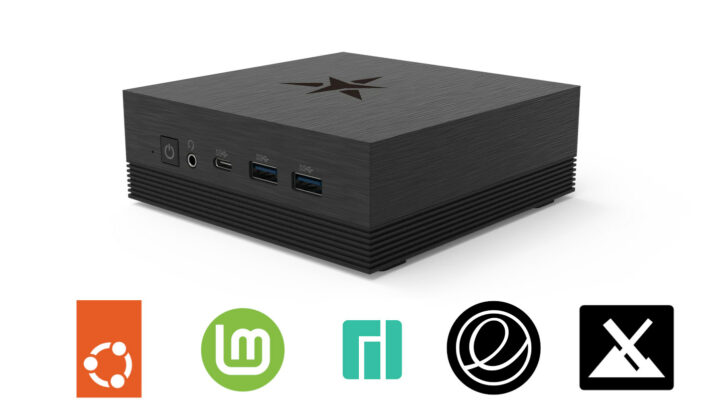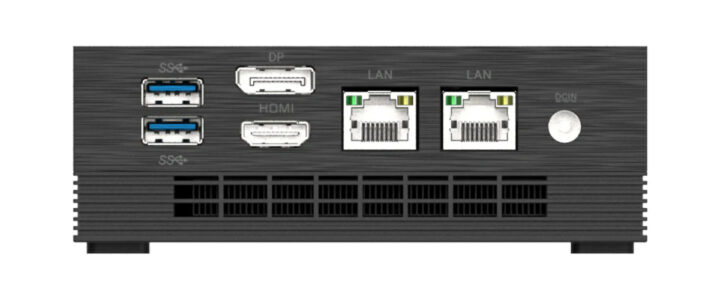Star Labs Byte Mk II is another Intel Alder Lake-N mini PC with an Intel Processor N200 CPU whose main differentiating factor is to ship with Linux pre-installed from a choice between Ubuntu 22.04, Linux Mint, Manjaro, Zorin OS, and many others.
The hardware features are quite standard with up to 16GB RAM, an NVMe SSD with up to 2TB capacity, HDMI and DisplayPort video outputs, an audio jack two Gigabit Ethernet ports, WiFi 5 and Bluetooth 5.1, and a few USB ports.
Star Labs Byte Mk II specifications:
- SoC – Intel Processor N200 quad-core processor @ up to 1.0 GHz / 3.7 GHz (Turbo) with 6MB cache, 32EU Intel HD graphics @ 750 MHz; TDP: 6W (PL2 set to 25W)
- System Memory – 8GB or 16GB single-channel DDR4 3200MHz memory via one SO-DIMM socket
- Storage
- 480GB “over-provisioned” M.2 2280 PCIe SSD (option for 960GB or 1920GB)
- Detachable 2.5-inch HDD/SSD via optional connector included
- Video Output
- HDMI 2.0 up to 4Kp60
- DisplayPort 1.4 up to 4Kp60
- Dual independent display support
- Audio – 3.5mm headphone jack
- Networking
- 2x Gigabit Ethernet RJ45 ports
- Wi-Fi 5 up to 1.73 Gbps and Bluetooth 5.1 via an Intel Wireless-AC 9560 M.2 2230 module
- USB
- 4x USB 3.2 Gen 2 (10 Gbps) Type-A ports
- 1x USB 3.0 (5 Gbps) Type-A port
- Security features
- BIOS Lock
- Secure Boot
- Measured Boot
- Disabled Intel Management Engine (IME)
- Misc – 1x Kensington Lock
- Power Adapter – 12V/3A via DC jack
- Dimensions – 12.7 x 12.7 x 4.3 cm (Polycarbonate and nickel housing)
- Weight – 296 grams
- Temperature range – Operating: 5° to 40°C; storage: -20° to 60°C
- Relative humidity – 0% to 90% non-condensing
- Altitude
- Operating – tested up to 3048 meters
- Storage/shipping – up to 12192 meters
The fanless mini PC also comes with Coreboot firmware which must be why the company managed to disable Intel Management Engine and Star Labs also offers the coreboot configurator for easy configuration. A total of 17 Linux distributions can be selected for the Processor N200 mini PC at no additional cost at the time of order:
- Ubuntu 22.04.02 LTS
- elementary OS 7 Pantheon
- Kubuntu 22.04.2 LTS
- Linux Mint 21.1 Cinnamon, MATE, or XFCE
- Manjaro 22 GNOME, Plasma, or XFCE
- MX Linux 21.3 XFCE, KDE, or Fluxbox
- Ubuntu 22.04.2 MATE LTS
- Xubuntu 22.04.2 LTS
- Zorin OS 16.2 Core, Lite
There are also some operating systems that require additional payment:
- Zorin OS 16.2 Pro
- Windows 11 Home or Professional
Or you can ask the company not to install any operating system if you prefer to do that yourself. People selecting Windows 11 are likely the ones who care about Intel IME being removed considering the price of the mini PC. There should not be an issue with WiFi and Bluetooth in Linux like on some other Alder Lake-N mini PCs with an Intel AX101 module, as they selected the Wireless-AC 9560 with support in Linux through the iwlwifi driver at least since Linux 4.14.
Getting a Linux mini PC removes the need to purchase a Windows license, but there are additional costs since it’s a niche market, they changed the firmware, the company lets the user select from a wide range of Linux distributions, and donations will be given to the developers of the selected OS. So if you want the Star Labs Byte Mk II mini PC, you’ll need to spend at least $452 for the model with 8GB RAM and a 480GB SSD. Note that’s the pre-order price, and the mini PC will then sell for $595 and up after the promotion period, which is significantly higher than Windows 11 mini PCs with similar specifications coming out of China. Additional information may be found on the product page.
Via Liliputing

Jean-Luc started CNX Software in 2010 as a part-time endeavor, before quitting his job as a software engineering manager, and starting to write daily news, and reviews full time later in 2011.
Support CNX Software! Donate via cryptocurrencies, become a Patron on Patreon, or purchase goods on Amazon or Aliexpress







Once again a device that both excites and disappoints in equal measure. Up to date processor, low Watts, linux, larger than needed ssd, 2.5″ drive option. But woooo, that price. 🤩🤷♂️🤮
Why would anybody spend what is an extortionate amount of money for something that runs free operating systems perfectly well on lesser and far cheaper hardware.?
The N200 is only small incremental step up from the N100, where boxes can be had for very reasonable prices.
A very minor difference. In fact CPUbenchmark is showing the n200 worse, though it’s probably measurement error. The n200 is essentially the same except for more graphics EUs.
The odd ducks of the lineup are the n95 and n97. They have the same or worse graphics as the n100, but they draw twice as much power … I don’t even see why they exist! But I did see a mini PC maker trying to sell a n97 one so they’re making it to market to some extent.
The n300 is legitimately better performing.
I think the machine is very appealing as an free software hardware. It’s size factor is same as those SFF boxes from big names Lenovo, HP and Dell, but price is half. Still a buyer with emphasis on FOSS gets better specs for FOSS than the comparative SFFs from the big names. Only complaint I have, is the specs for wired network. Why can’t they be 2.5Gbps and, what I checked, no option for expansion to wired network capasity.
As an hype video and a comparison for SFF hardware see this video:
https://youtu.be/HylKpDmwaFA
My hw use case is to have 2-3 units of SFF boxes all running free software and everything from soft router to home automation in an virtualized environment, where services move fast from box to box and one box being capabable to run all services if needed. With the prices from big name boxes the 2-3 units become too expensive, I’m not willing to pay and especially those lacking the free software emphasis this box have.
Meanwhile, I bought an 5700U Mini-PC with 2 slot RAM, 1×2280 1×2240 and Wifi6/BT5.2 for $214 on AliExpress.
Link or never happened please 😉
You could go to AliExpress and type ‘Ryzen 7 5700u. Here’s one of them, with 7730u instead of 5700u: https://www.aliexpress.com/item/1005005548385903.html
I don’t exactly understand this. Why does the vendor feel they have to change the firmware and disable ime to install Linux? I’ve never run into a problem installing Linux on an Intel platform, leaving the firmware as the OEM provided it. It seems like their insistence on doing so is adding a lot of costs, because this PC is MUCH more costly than many others with the similar n100 CPU….
There’s a vocal community of users who don’t trust Intel IME and consider it spyware. The EFF deemed it a security hazard a few years ago.
https://www.cnx-software.com/2017/11/07/minix-based-intel-management-engine-firmware-uefi-are-closed-source-insecure-nerf-to-the-rescue/
So removing it will be a selling point to some. It has nothing to do with the ability to install Linux.
Thanks! Personally, I’ll file that concern away under “I have enough problems in my life already” 😀
$595 for a chinese Mini PC with those specs?
The price is so insulting that they don’t even deserve an article about it. Let’s forget it for good 🙁
> $595 for a chinese Mini PC with those specs?
Chinese? That’s why they calculate their prices in £ and ship from the UK?
> The price is so insulting
You might want to improve your reading skills a bit to grasp what is special with this type of device?